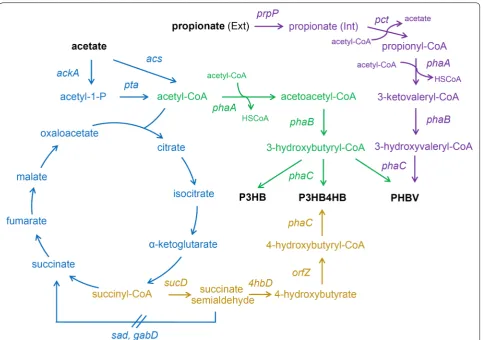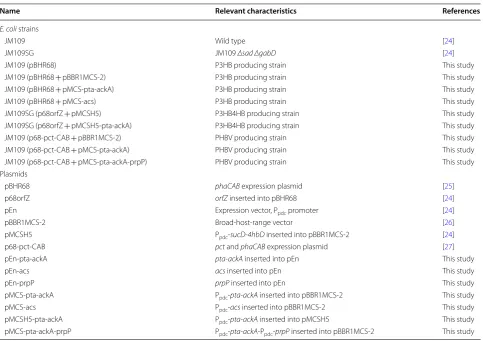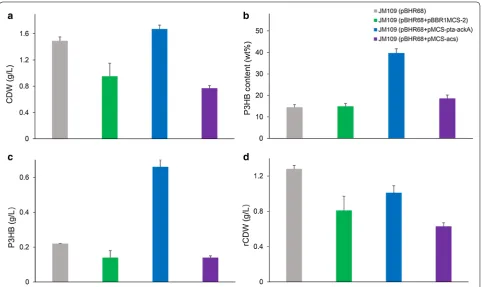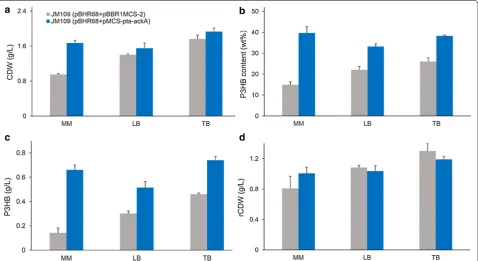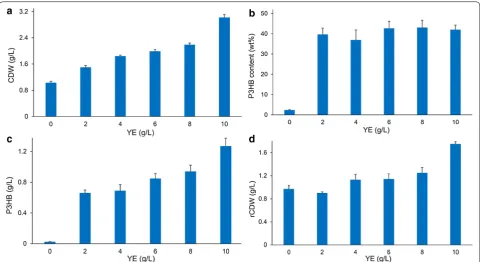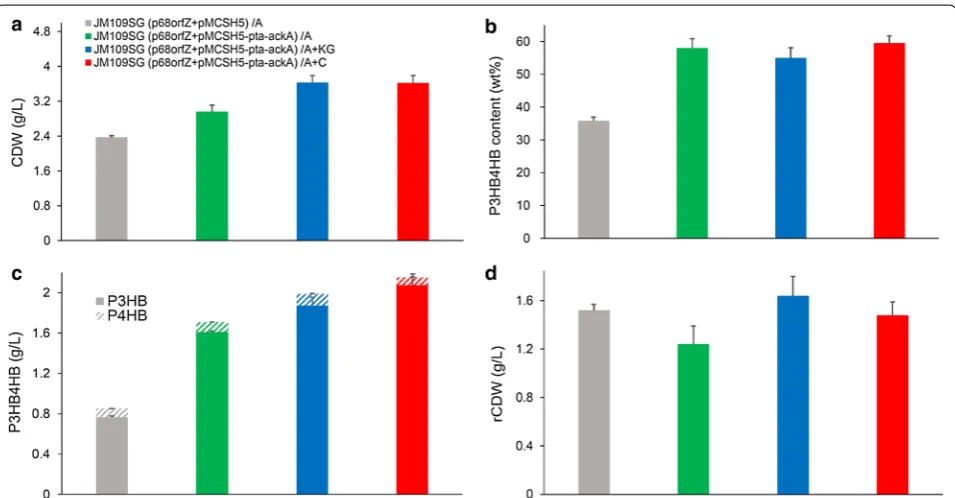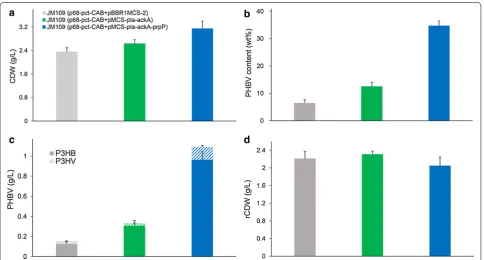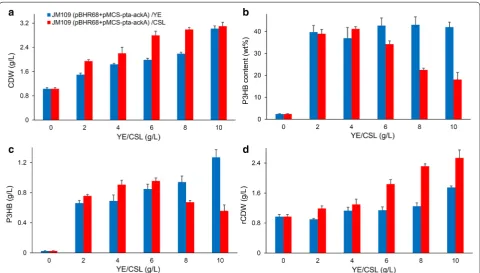RESEARCH
Metabolic engineering of
Escherichia coli
for the synthesis of polyhydroxyalkanoates
using acetate as a main carbon source
Jing Chen
1,2, Wei Li
1,2, Zhao‑Zhou Zhang
2, Tian‑Wei Tan
2and Zheng‑Jun Li
1,2*Abstract
Background: High production cost of bioplastics polyhydroxyalkanoates (PHA) is a major obstacle to replace tradi‑ tional petro‑based plastics. To address the challenges, strategies towards upstream metabolic engineering and down‑ stream fermentation optimizations have been continuously pursued. Given that the feedstocks especially carbon sources account up to a large portion of the production cost, it is of great importance to explore low cost substrates to manufacture PHA economically.
Results: Escherichia coli was metabolically engineered to synthesize poly‑3‑hydroxybutyrate (P3HB), poly(3‑hydroxy‑ butyrate‑co‑4‑hydroxybutyrate) (P3HB4HB), and poly(3‑hydroxybutyrate‑co‑3‑hydroxyvalerate) (PHBV) using acetate as a main carbon source. Overexpression of phosphotransacetylase/acetate kinase pathway was shown to be an effective strategy for improving acetate assimilation and biopolymer production. The recombinant strain overexpress‑ ing phosphotransacetylase/acetate kinase and P3HB synthesis operon produced 1.27 g/L P3HB when grown on mini‑ mal medium supplemented with 10 g/L yeast extract and 5 g/L acetate in shake flask cultures. Further introduction succinate semialdehyde dehydrogenase, 4‑hydroxybutyrate dehydrogenase, and CoA transferase lead to the accumu‑ lation of P3HB4HB, reaching a titer of 1.71 g/L with a 4‑hydroxybutyrate monomer content of 5.79 mol%. When 1 g/L of α‑ketoglutarate or citrate was added to the medium, P3HB4HB titer increased to 1.99 and 2.15 g/L, respectively. To achieve PHBV synthesis, acetate and propionate were simultaneously supplied and propionyl‑CoA transferase was overexpressed to provide 3‑hydroxyvalerate precursor. The resulting strain produced 0.33 g/L PHBV with a 3‑hydroxy‑ valerate monomer content of 6.58 mol%. Further overexpression of propionate permease improved PHBV titer and 3‑hydroxyvalerate monomer content to 1.09 g/L and 10.37 mol%, respectively.
Conclusions: The application of acetate as carbon source for microbial fermentation could reduce the consumption of food and agro‑based renewable bioresources for biorefineries. Our proposed metabolic engineering strategies illustrate the feasibility for producing polyhydroxyalkanoates using acetate as a main carbon source. Overall, as an abundant and renewable resource, acetate would be developed into a cost‑effective feedstock to achieve low cost production of chemicals, materials, and biofuels.
Keywords: Acetate, Escherichia coli, Poly‑3‑hydroxybutyrate, Poly(3‑hydroxybutyrate‑co‑4‑hydroxybutyrate), Poly(3‑ hydroxybutyrate‑co‑3‑hydroxyvalerate)
© The Author(s) 2018. This article is distributed under the terms of the Creative Commons Attribution 4.0 International License (http://creat iveco mmons .org/licen ses/by/4.0/), which permits unrestricted use, distribution, and reproduction in any medium, provided you give appropriate credit to the original author(s) and the source, provide a link to the Creative Commons license, and indicate if changes were made. The Creative Commons Public Domain Dedication waiver (http://creat iveco mmons .org/ publi cdoma in/zero/1.0/) applies to the data made available in this article, unless otherwise stated.
Open Access
*Correspondence: lizj@mail.buct.edu.cn
1 Beijing Advanced Innovation Center for Soft Matter Science
Background
Food and agro-based renewable bioresources, such as xylose [1], glucose [2], sucrose [3], and starch [4], are most widely used carbon feedstocks for the microbial production of polymers, biofuels and building block chemicals. Polyhydroxyalkanoates (PHA), the promis-ing biodegradable polyesters which are produced by an extensive variety of microorganisms for carbon and energy storage purposes, are also synthesized from glucose as a main carbon source [5, 6]. Although con-siderable efforts have been devoted to decreasing the production cost of PHA to make it economically com-petitive, the present price of PHA is still not feasible to replace traditional petro-based plastics [7]. It is believed that the feedstocks especially carbon source accounts up to a large portion of the production cost. Therefore, it is important to develop low cost substrates to make PHA economically competitive [8]. In addition, the global food shortage and the price increases of agricultural prod-ucts have made it difficult to rely on food-based materi-als as fermentation feedstocks, in addition to the ethical considerations involved with doing so. Consequently, the development of non-food based substrates, such as methanol [9], acetate [10], and syngas [11], is quickly becoming one of the most important research areas of industrial biotechnology.
Acetate is the second simplest carboxylic acid, and many microorganisms can utilize acetate as alternative carbon source for cell growth. The acetate assimilation species include Escherichia coli [12], Cryptococcus cur-vatus [13], Clostridium sp. [14], Halomonas boliviensis
[15], and so on. Recent studies have demonstrated that acetate can be produced from low cost substrates via bio-chemical processes. For example, acetate is a major fer-mentation product during anaerobic digestion of organic wastes and syngas production by acetogenic bacteria
Moorella thermoacetica from carbon dioxide [16, 17]. In addition, acetate is also widely existed as a byproduct from hydrolysis or pyrolysis of lignocellulosic biomass [18, 19]. In this regard, compared with glucose, acetate would be a promising cost-effective carbon source suit-able for microbial fermentation.
Oleaginous yeasts including C. curvatus [20] and Yar-rowia lipolytica [21] have been reported to utilize waste acetate as a main carbon source to accumulate lipids. Although acetate is a notorious cell growth inhibitor for
E. coli fermentation, recombinant E. coli strains were constructed to use acetate for the production of free fatty acids [22] and succinate [23]. Therefore, it is also quite interesting to investigate the possibility of producing PHA polymers from acetate.
In this study, the metabolic pathways of E. coli
were engineered to produce poly-3-hydroxybutyrate
(P3HB), poly(3-hydroxybutyrate-co-4-hydroxybutyrate)
(P3HB4HB), and poly(3-hydroxybutyrate-co
-3-hydroxy-valerate) (PHBV) using acetate as a main carbon source (Fig. 1). We compared the effects of overexpressing phos-photransacetylase/acetate kinase and AMP-forming acetyl-CoA synthetase on acetate assimilation and P3HB production. In addition, succinate semialdehyde dehy-drogenase, 4-hydroxybutyrate dehydehy-drogenase, and CoA transferase was overexpressed to construct P3HB4HB accumulation pathway. Propionyl-CoA transferase and propionate permease were introduced to provide 3-hydroxyvalerate precursor from propionate, which helped to achieve PHBV synthesis. Our results demon-strate that P3HB, P3HB4HB, and PHBV can be effec-tively synthesized using acetate as a main carbon source, opening new approaches for the utilization of this cheap carbon source for the production of various high value-added biomaterials.
Methods
Bacterial strains and culture medium
Escherichia coli JM109 was employed as the host for plasmid construction and P3HB and PHBV production studies, while its succinate semialdehyde dehydrogenase
mutant JM109SG [24] was used as the host for P3HB4HB
production.
For construction of recombinants and plasmid ampli-fication, E. coli strains were cultivated in Luria–Bertani (LB) medium at 37 °C and 200 rpm. LB medium con-tained 5 g/L yeast extract, 10 g/L Bacto tryptone, and 10 g/L NaCl. To maintain plasmid stability, 100 μg/mL ampicillin and/or 50 μg/mL kanamycin was added to the media when required.
Plasmid construction
Strains and plasmids used in this study are listed in Table 1. Oligonucleotides used in this study are listed in Additional file 1: Table S1. Standard molecular clon-ing procedures or manufacturers’ instructions were fol-lowed for plasmid construction. Q5® High-Fidelity DNA Polymerase from New England Biolabs (Ipswich, MA, US) was employed for PCR reactions. Plasmid isolation and DNA purification kits were purchased from Biomed (Beijing, China). Restriction enzymes and DNA modify-ing enzymes were purchased from New England Biolabs.
The pta-ackA encoding
phosphotransacetylase/ace-tate kinase and acs encoding acetyl-CoA synthetase
were amplified from E. coli genomic DNA using
respectively. Moreover, Ppdc promoter and gene cod-ing sequence were removed from pEn-derived plas-mids and subcloned into kanamycin resistance carrying broad-host-range cloning vector pBBR1MCS-2 to gen-erate pMCS-pta-ackA and pMCS-acs, respectively.
Primers pa2F/pa2R were designed to amply pta-ackA
from pEn-pta-ackA. The PCR product was digested with NheI/XhoI and cloned into the sucD-4hbD expres-sion vector pMCSH5 cut with the same enzymes to form pMCSH5-pta-ackA. Primers prpPF/prpPR were
designed to amply prpP encoding propionate permease
from Ralstonia eutropha H16 genomic DNA. The PCR
product was digested with BamHI/HindIII and cloned
into pEn to generate pEn-prpP. Subsequently, Ppdc-prpP was excised from pEn-prpP using SpeI/XhoI and cloned
into pMCS-pta-ackA digested with NheI/XhoI to
gen-erate pMCS-pta-ackA-prpP.
Growth conditions for biopolymer production
To prepare the seed cultures, 10 μL of glycerol stock was inoculated into 20 mL of LB medium and cultivated at 37 °C and 200 rpm for 12 h. For biopolymer producing shake flask studies, 4% (v/v) of the seed culture was used to inoculate into 500 mL shake flasks containing 50 mL of medium and cultured at 37 °C and 200 rpm for 48 h.
The plasmids including pBBR1MCS-2,
pMCS-pta-ackA, and pMCS-acs, each in combination with phaCAB
expression plasmid pBHR68, were co-transformed into
medium (MM). TB medium contained 24 g/L yeast extract, 12 g/L Bacto tryptone, 2.31 g/L KH2PO4, and 12.54 g/L K2HPO4. MM medium comprised 2 g/L NH4Cl, 5.0 g/L (NH4)2SO4, 6.0 g/L KH2PO4, 8.4 g/L MOPS, 0.5 g/L NaCl, 0.24 g/L MgSO4, 0.002 g/L Na2MoO4 and 1 mL/L trace element solution. The trace elements solu-tion contained (g/L): FeCl2·4H2O 3.6, CaCl2·2H2O 5.0, MnCl2·2H2O 1.3, CuCl2·2H2O 0.38, CoCl2·6H2O 0.5, ZnCl2 0.94, H3BO3 0.0311, Na2EDTA·2H2O 0.4, and thia-mine-HCl 1.01. When necessary, MM medium was sup-plemented with a certain amount of yeast extract.
Plasmids pMCSH5 and pMCSH5-pta-ackA, each together with phaCAB-orfZ expression plasmid p68orfZ,
were co-transformed into E. coli JM109SG to
gener-ate P3HB4HB producing strains. The resulting recom-binants were cultivated in MM medium supplemented with 10 g/L yeast extract and 5 g/L acetate for P3HB4HB accumulation. When necessary, α-ketoglutarate or citrate was added as a second carbon source at a concentration of 1 g/L.
Plasmids pBBR1MCS-2, pMCS-pta-ackA, and
pMCS-pta-ackA-prpP, each together with pct-phaCAB
expression plasmid p68-pct-CAB, were co-transformed into E. coli JM109 to generate PHBV producing strains. The resulting recombinants were cultivated in MM medium supplemented with 10 g/L yeast extract, 5 g/L acetate, and 1.5 g/L propionate for PHBV production.
Analytical methods
Bacterial cells were harvested by centrifugation at 8000g
for 10 min. The cell pellets were washed twice with dis-tilled water and then lyophilized for 12 h for cell dry weight (CDW) measurement. Lyophilized cells were sub-jected to methanolysis at 100 °C for 4 h in the presence of 3% (v/v) H2SO4. Intracellular polymer content (wt%) and composition was analyzed using gas chromatography (GC) (Hewlett-Packard 6890) equipped with a capillary column HP-5 (30 m, 0.25 mm) and a flame-ionization detector. PHBV and γ-butyrolactone purchased from Sigma-Aldrich (St. Louis, MO, USA) were used as analy-sis standards. Residual cell weight (rCDW) is defined as non-PHA cell mass. rCDW in each sample was deter-mined by substracting the PHA concentration measured by GC analysis from CDW.
Table 1 Strains and plasmids used in this study
Name Relevant characteristics References
E. coli strains
JM109 Wild type [24]
JM109SG JM109 Δsad ΔgabD [24]
JM109 (pBHR68) P3HB producing strain This study
JM109 (pBHR68 + pBBR1MCS‑2) P3HB producing strain This study
JM109 (pBHR68 + pMCS‑pta‑ackA) P3HB producing strain This study
JM109 (pBHR68 + pMCS‑acs) P3HB producing strain This study
JM109SG (p68orfZ + pMCSH5) P3HB4HB producing strain This study
JM109SG (p68orfZ + pMCSH5‑pta‑ackA) P3HB4HB producing strain This study
JM109 (p68‑pct‑CAB + pBBR1MCS‑2) PHBV producing strain This study
JM109 (p68‑pct‑CAB + pMCS‑pta‑ackA) PHBV producing strain This study
JM109 (p68‑pct‑CAB + pMCS‑pta‑ackA‑prpP) PHBV producing strain This study
Plasmids
pBHR68 phaCAB expression plasmid [25]
p68orfZ orfZ inserted into pBHR68 [24]
pEn Expression vector, Ppdc promoter [24]
pBBR1MCS‑2 Broad‑host‑range vector [26]
pMCSH5 Ppdc‑sucD‑4hbD inserted into pBBR1MCS‑2 [24]
p68‑pct‑CAB pct and phaCAB expression plasmid [27]
pEn‑pta‑ackA pta‑ackA inserted into pEn This study
pEn‑acs acs inserted into pEn This study
pEn‑prpP prpP inserted into pEn This study
pMCS‑pta‑ackA Ppdc‑pta‑ackA inserted into pBBR1MCS‑2 This study
pMCS‑acs Ppdc‑acs inserted into pBBR1MCS‑2 This study
pMCSH5‑pta‑ackA Ppdc‑pta‑ackA inserted into pMCSH5 This study
For acetate detection, the supernatant of culture broth was filtered through a 0.2-μm syringe filter and stored chilled for high-performance liquid chromatog-raphy (HPLC) analysis equipped with an ion exchange
column (Aminex® HPX-87H, BioRad) and a refractive
index detector (RI-150, Thermo Spectra System, USA). A mobile phase of 7 mM H2SO4 at a 0.6 mL/min flow rate was used.
Results and discussion
Pathway construction for P3HB synthesis from acetate Over the past few decades, researchers have mainly been studying the “acetate switch” with the aim to enable microorganisms to efficiently consume acetate that is produced by their own metabolism to eliminate the toxic-ity of acetate to cell growth [28, 29]. Nonetheless, acetate could be a potential cost-effective feedstock for synthe-sis of value-added chemicals. Recently, the feasibility of converting acetate to poly-3-hydroxybutyrate (P3HB) and succinate was demonstrated in Y. lipolytica [30] and
E. coli [23], respectively. Moreover, co-production of
hydrogen and P3HB with engineered E. coli on glucose
and acetate under anaerobic condition was reported. The addition of acetate to the culture as part of carbon source
significantly increased P3HB production, yet the P3HB titer was still below 0.04 g/L [31].
To investigate the possibility of P3HB production using
acetate as a main carbon source in E. coli, P3HB
syn-thesis operon phaCAB carrying plasmid pBHR68 was
transformed into E. coli JM109, and the recombinant
strain was inoculated into MM medium supplemented with 2 g/L yeast extract and 5 g/L acetate (Fig. 2). After
48 h shake flask cultivation, E. coli JM109 (pBHR68)
consumed all the acetate and yielded 1.49 g/L CDW with 0.22 g/L P3HB accumulation, which indicated that P3HB could be produced from acetate, yet the P3HB titer
was much lower than that obtained from glucose [32].
Therefore, further metabolic engineering strategies were applied to improve P3HB accumulation from acetate.
Pathway engineering for improved P3HB accumulation In E. coli, there are two potential routes for the genera-tion of acetyl-CoA from acetate: phosphotransacetylase/
acetate kinase (pta-ackA pathway) and AMP-forming
acetyl-CoA synthetase (acs pathway) (Fig. 1). These two pathways were augmented through the overexpression of pta-ackA and acs genes, respectively. Shake flask cul-tivations in acetate containing MM medium showed that
JM109 (pBHR68 + pMCS-pta-ackA) consumed 5 g/L acetate and produced 0.66 g/L P3HB. The P3HB produc-tion titer of was roughly four times of that produced by
control strain JM109 (pBHR68 + pBBR1MCS-2). By
con-trast, the overexpression of acs gene has little effect on improving P3HB accumulation (Fig. 2). The activation of each molecule of acetate for acetyl-CoA synthesis in acs
pathway requires two molecule of ATP, while pta-ackA
pathway consumes only one molecule of ATP for acetyl-CoA synthesis [22, 33]. It was reported also that the growth of E. coli stains on low concentrations of acetate
depends on acs pathway, while growth on high
concen-trations requires pta-ackA pathway [28, 29]. Therefore, the engineering of the pta-ackA pathway to strengthen acetate assimilation was considered to be an effective strategy for improving P3HB production in recombinant
E. coli.
Optimizing culture conditions to increase P3HB production
The engineered E. coli JM109 (pBHR68 +
pMCS-pta-ackA) and control strain JM109
(pBHR68 + pBBR1MCS-2) were cultivated in shake flasks
with LB, TB, and MM medium to evaluate the effects of medium composition on cell growth and P3HB accumu-lation (Fig. 3). Initial acetate concentration was 5 g/L and MM medium was supplemented with 2 g/L yeast extract.
After 48 h cultivation, no acetate was left in the medium for all groups. The recombinant strain harboring extra
pta-ackA genes produced more CDW and P3HB in the
three different kinds of culture media, further demon-strated that pta-ackA overexpression was effective for
improving P3HB production from acetate (Fig. 3). With
MM medium, JM109 (pBHR68 + pMCS-pta-ackA)
pro-duced 1.67 g/L CDW, containing 0.66 g/L P3HB, while the use of LB and TB medium resulted in 1.55 g/L CDW with 0.52 g/L P3HB, and 1.93 g/L CDW with 0.74 g/L P3HB, respectively. TB medium helped to obtain higher CDW and P3HB titer than those achieved in MM and LB medium. Among three culture conditions, MM medium possesses lowest cost and resulted in acceptable P3HB titer. Therefore, it was considered to be a favorable medium for the production of P3HB from acetate.
Next, different concentration (0, 2, 4, 6, 8, 10 g/L) of yeast extract were added to MM medium to study its potential for enhancing cell growth and P3HB accumula-tion (Fig. 4). When yeast extract was not provided, CDW of E. coli JM109 (pBHR68 + pMCS-pta-ackA) reached 1.03 g/L, and P3HB concentration was only 0.02 g/L. The CDW and P3HB accumulation increased gradually with the increase of yeast extract concentration, although the intracellular P3HB content did not change obviously. The addition of 10 g/L yeast extract yielded 3.02 g/L CDW,
containing 1.27 g/L P3HB, which was the highest P3HB production titer obtained in this study. The production yield was 0.25 g P3HB/g acetate, which was 35% of the maximal theoretical yield. It has been shown that yeast extract contributes a large amount of amino acids for biomass growth, thus the addition of complex nitrogen sources such as yeast extract to defined medium saved NADPH for amino acids synthesis and increased intra-cellular NADPH level as well as NADPH/NADP ratio
[34]. P3HB biosynthesis is a NADPH-dependent pathway
and high NADPH level and availability were considered to be of great importance for the efficient synthesis of PHB in recombinant E. coli [32]. Therefore, we specu-late that the addition of yeast extract favored cell growth and intracellular NADPH availability which in turn led to high biomass and P3HB production.
We next cultivated E. coli JM109 (pBHR68 +
pMCS-pta-ackA) using MM medium supplemented with 10 g/L yeast extract and different concentration (0, 1, 2, 3, 4, 5 g/L) of acetate to evaluate the effect of acetate concen-tration on P3HB accumulation. As shown in Additional
file 1: Figure S1, when acetate was not provided, the
CDW reached 1.15 g/L and the intracellular P3HB tent was only 3.23 wt%. With the increase of acetate con-centration, the CDW, P3HB content, and P3HB titer all
increased gradually. The addition of 5 g/L acetate led to the highest P3HB content of 42.02 wt%. Although yeast extract was provided at a relatively high level, P3HB syn-thesis was still limited by acetate addition. In contrast, the results of shake flask cultures using 5 g/L acetate and different amounts of yeast extract showed that the P3HB content did not change obviously when yeast extract concentration increased from 2 to 10 g/L (Fig. 4). These results demonstrated that the carbon source existed in yeast extract was not able to support effective P3HB syn-thesis, and acetate was the main carbon source to synthe-size P3HB.
Production of P3HB4HB from acetate
Poly(3-hydroxybutyrate-co-4-hydroxybutyrate)
engineered E. coli that can produce P3HB4HB from ace-tate as carbon source.
The genes involved in succinate degradation path-way of Clostridium kluyveri, including sucD, 4hbD,
and orfZ [37], was combined with P3HB synthesis
operon phaCAB to construct P3HB4HB producing
pathway. E. coli native succinate semialdehyde
dehy-drogenase genes sad and gabD were both deleted
for eliminating succinate formation from succinate
semialdehyde (Fig. 1). The resulting strain JM109SG
(p68orfZ + pMCSH5) was able to achieve 2.37 g/L
CDW containing 35.79 wt% P(3HB-co-9.48 mol%
4HB) when grown in mineral medium supplemented with 10 g/L yeast extract and 5 g/L acetate (Fig. 5).
In addition, the pta-ackA genes were overexpressed
to strengthen acetate assimilation, and the
recom-binant JM109SG (p68orfZ + pMCSH5-pta-ackA)
yielded 2.96 g/L CDW, containing 58.01 wt%
P(3HB-co-5.79 mol% 4HB) (Fig. 5). In terms of P3HB4HB
production titer, pta-ackA overexpression resulted in 1.71 g/L, significantly higher than 0.85 g/L of the
con-trol strain without pta-ackA overexpression. These
results were consistent with previous P3HB produc-ing studies, and it appears that the pta-ackA plasmid carrying recombinants were more productive than the strains without pta-ackA overexpression.
Influence of TCA cycle intermediates on P3HB4HB synthesis
Previously, the addition of TCA cycle intermediates including α-ketoglutarate and citrate were found to be effective for increasing metabolic flux into 4HB
precur-sor when glucose was employed as carbon source [24].
Therefore, shake flask cultures were performed to evalu-ate the effects of α-ketoglutarevalu-ate and citrevalu-ate addition on cell growth and P3HB4HB accumulation profiles in case of acetate as a main carbon source. As shown in Fig. 5, when 1 g/L of α-ketoglutarate was added, the recombi-nant E. coli reached 3.63 g/L CDW, containing 54.97 wt%
P(3HB-co-5.80 mol% 4HB). Similarly, the addition of
1 g/L citrate as joint carbon source resulted in 3.62 g/L
CDW, containing 59.48 wt% P(3HB-co-3.43 mol% 4HB).
The addition of α-ketoglutarate and citrate as additional carbon sources increased the cell growth and P3HB4HB production, but had no obvious effect on improving 4HB monomer content.
When E. coli metabolizes acetate as a sole carbon and energy source, the genes involved in acetate uptake, gly-oxylate cycle, TCA cycle, and gluconeogenesis were all
up-regulated [12]. The addition of α-ketoglutarate or
citrate could improve the supply of TCA cycle interme-diates, thus may benefit cell growth and acetate assimila-tion. However, on this occasion, 4HB monomer content
was not increased, indicating the metabolic flux towards 4HB precursor synthesis was still limited in spite of improved TCA cycle intermediate supply.
Production of PHBV from acetate and propionate
Poly(3-hydroxybutyrate-co-3-hydroxyvalerate) (PHBV) is more flexible and tougher than P3HB homopolymer and has been commercially produced for many years [7]. The normal PHBV synthesis process requires the addition of propionate as assistant carbon source to generate propi-onyl-CoA, which was the precursor of 3-hydroxyvalerate (3HV) monomer (Fig. 1) [38]. The conversion of propi-onate to propionyl-CoA could be catalyzed by the ATP-dependent propionyl-CoA synthetase or propionyl-CoA transferase (Pct). When acetate was employed as carbon source, the intracellular pool size of acetyl-CoA should be favorable for transferring a CoA group from acetyl-CoA to propionate. To study the possibility of PHBV synthesis from acetate and propionate, plasmid
p68-pct-CAB, harboring Megasphaera elsdenii
propionyl-CoA transferase and P3HB synthesis operon phaCAB,
was co-transformed with pMCS-pta-ackA into E. coli
JM109. The resulting recombinant reached 2.64 g/L
CDW, containing 12.52 wt% P(3HB-co-6.58 mol% 3HV)
(Fig. 6). In contrast, the control strain JM109
(p68-pct-CAB +pBBR1MCS-2) only reached 2.36 g/L CDW
containing 6.48 wt% P(3HB-co-15.80 mol% 3HV) under
the same culture condition. PHBV production titer was increased from 0.15 to 0.33 g/L with pta-ackA
overex-pression, further demonstrating that pta-ackA
over-expression was an effective strategy for improving acetate-dependent biopolymer synthesis.
Previously, recombinant E. coli harboring phaCAB
operon and propionate permease (or propionyl-CoA syn-thase) failed to incorporate 3HV into the biopolymer in M9 medium containing 2 g/L yeast extract, 1 g/L sodium propionate, and 20 g/L sodium acetate [39]. However, a high concentration of yeast extract (10 g/L) was used in this study. It was speculated that a high concentration of yeast extract favors cell growth. In addition, propio-nyl-CoA transferase used acetyl-CoA and propionate to produce propionyl-CoA, yielding the precursor for 3HV incorporation. Therefore, our engineering strategy sug-gest that PHBV could be produced from acetate and pro-pionate, yet the biopolymer content was lower than that achieved for P3HB or P3HB4HB.
Next, prpP gene encoding propionate permease of R.
eutropha H16 was overexpressed to study its effect on
PHBV synthesis. E. coli JM109 (p68-pct-CAB +
pMCS-pta-ackA-prpP) resulted in 3.15 g/L CDW,
contain-ing 34.77 wt% P(3HB-co-10.37 mol% 3HV) (Fig. 6).
The overexpression of propionate permease improved
PHBV production titer from 0.33 to 1.09 g/L. Mean-while, 3HV monomer content was increased from 6.58 to 10.37 mol%. Similar phenomenon were also observed in previous studies, in which overexpression of PrpP not only increased the 3HV monomer content but also
pro-moted the biopolymer accumulation [40]. Propionate
permease is responsible for the uptake of propionate and PrpP overexpression may improve the pool of intracel-lular propionate for propionyl-CoA formation. Thus, it was reasonable to find that 3HV fraction in PHBV was increased with PrpP overexpression. However, the rea-son for improved biopolymer production caused by PrpP overexpression was not clear and need to be discussed further.
Use of corn steep liquor as an economical nitrogen source Yeast extract was proved to be a critical nutritional
sup-plement for improved PHA production (Fig. 4). To
reduce the feedstock cost, many studies tried to develop cheaper supplements which can be used as an alterna-tive or in combination with yeast extract. Corn steep liquor, a low-cost byproduct of the corn wet-milling pro-cess, contains a large amount of amino acids, peptides and vitamins [41]. Therefore, there have been increasing
studies on the utilization of corn steep liquor as a nitro-gen source for microbial fermentations [42, 43].
Shake flask cultivations using various concentration (2, 4, 6, 8, 10 g/L) of corn steep liquor instead of yeast extract
were performed (Fig. 7). The CDW of E. coli JM109
(pBHR68 + pMCS-pta-ackA) increased gradually with
the increase of corn steep liquor concentration, yet the P3HB production exhibit a trend of first increasing then decreasing. The addition of 4 g/L and 6 g/L of corn steep liquor to MM medium containing 5 g/L acetate yielded 0.91 and 0.96 g/L P3HB, respectively. Although 10 g/L corn steep liquor addition led to highest CDW among the different corn steep liquor concentration condition, the P3HB concentration was only 0.56 g/L. Therefore, the favorable corn steep liquor concentration for P3HB pro-duction was 4–6 g/L under our culture condition. These results indicated that P3HB can be synthesized when corn steep liquor is employed as a nitrogen source, albeit with somewhat lower efficiency in comparison with yeast extract. The use of corn steep liquor for PHA production from acetate therefore merits further research.
In addition, we performed shake flask studies without acetate addition to evaluate the contribution of CSL to P3HB production. As shown in Additional file 1: Table S2,
E. coli JM109 (pBHR68 + pMCS-pta-ackA) showed the highest P3HB accumulation of 0.04 g/L among all strains studied when cultivated in MM medium supplemented with 6 g/L CSL. The P3HB titer obtained without ace-tate was much lower than that achieved by aceace-tate sup-plementation. These results further demonstrated that acetate was served as the main carbon source to support effective P3HB synthesis.
Conclusions
In this study, E. coli was engineered to synthesize P3HB, P3HB4HB, and PHBV using acetate as a main carbon source. The production of biopolymers was significantly improved by the overexpression of phosphotransacety-lase and acetate kinase. In shake flask cultures, the
engi-neered E. coli produced 1.27 g/L of P3HB and 1.71 g/L
P(3HB-co-5.79 mol% 4HB), respectively, with minimal
medium supplemented 10 g/L yeast extract and 5 g/L acetate. When 1 g/L citrate was added as assistant car-bon source, P3HB4HB production titer was increased to 2.15 g/L. The overexpression of propionyl-CoA trans-ferase and propionate permease lead to a production
titer of 1.09 g/L P(3HB-co-10.37 mol% 3HV) when 5 g/L
acetate and 1.5 g/L propionate were simultaneously sup-plied. To our knowledge, this is the first study reporting the efficient production of P3HB, P3HB4HB, and PHBV
using acetate as a main carbon source by engineered E.
coli.
Abbreviations
PHA: polyhydroxyalkanoates; P3HB: poly‑3‑hydroxybutyrate; P3HB4HB: poly(3‑ hydroxybutyrate‑co‑4‑hydroxybutyrate); PHBV: poly(3‑hydroxybutyrate‑co‑ 3‑hydroxyvalerate); 3HB: 3‑hydroxybutyrate; 4HB: 4‑hydroxybutyrate; 3HV: 3‑hydroxyvalerate; LB: Luria–Bertani; TB: terrific broth; MM: minimal medium; YE: yeast extract; CSL: corn steep liquor; A: acetate; KG: α‑ketoglutarate; C: citrate; CDW: cell dry weight; rCDW: residual cell dry weight; GC: gas chroma‑ tography; HPLC: high‑performance liquid chromatography.
Authors’ contributions
JC and WL performed the experiments; ZZZ assisted the gas chromatography analysis; ZJL wrote the manuscript; ZJL and TWT supervised this study. All authors read and approved the final manuscript.
Author details
1 Beijing Advanced Innovation Center for Soft Matter Science and Engineer‑
ing, Beijing University of Chemical Technology, Mailbox 53, No. 15 Beisanhuan Donglu, Chaoyang District, Beijing 100029, China. 2 Beijing Key Laboratory
of Bioprocess, College of Life Science and Technology, Beijing University of Chemical Technology, Beijing 100029, China.
Additional file
Additional file 1: Table S1. Oligonucleotides used in this study. Table S2.
P3HB production by E. coli strains cultivated in MM medium supple‑ mented with CSL. Figure S1. Effect of acetate concentration on cell growth and P3HB production.
Acknowledgements
Not applicable.
Competing interests
The authors declare that they have no competing interests.
Availability of data and materials
All data generated during this study are included in this published article.
Consent for publication
All authors agree to submit the work to the journal.
Ethics approval and consent to participate
Not applicable.
Funding
This research was supported by Grants from National Natural Science Founda‑ tion of China (21476014), National Science & Technology Pillar Program of China (2015BAD15B09), Higher Education and Highquality and Worldclass Universities (BUCTYLKXJ03) and the Fundamental Research Funds for the Central Universities (XK1701).
Publisher’s Note
Springer Nature remains neutral with regard to jurisdictional claims in pub‑ lished maps and institutional affiliations.
Received: 25 February 2018 Accepted: 26 June 2018
References
1. Farias D, Atala DIP, Maugeri F. Improving bioethanol production by Schef-fersomyces stipitis using retentostat extractive fermentation at high xylose concentration. Biochem Eng J. 2017;6:171–80.
2. Ye XT, Honda K, Morimoto Y, Okano K, Ohtake H. Direct conversion of glucose to malate by synthetic metabolic engineering. J Biotechnol. 2013;164:34–40.
3. Ma JF, Li F, Liu RM, Liang LY, Ji YL, Wei C, Jiang M, Jia HH, Ouyang P. Succinic acid production from sucrose and molasses by metabolically engineered E. coli using a cell surface display system. Biochem Eng J. 2014;91:240–9.
4. Bai FW, Anderson WA, Moo‑Young M. Ethanol fermentation technologies from sugar and starch feedstocks. Biotechnol Adv. 2008;26:89–105. 5. Chen GQ, Hajnal I, Wu H, Lv L, Ye JW. Engineering biosynthesis
mechanisms for diversifying polyhydroxyalkanoates. Trends Biotechnol. 2015;33:565–74.
6. Chen GQ, Jiang XR, Guo Y. Synthetic biology of microbes synthesizing polyhydroxyalkanoates (PHA). Synth Syst Biotechnol. 2016;1:236–42. 7. Chen GQ. A microbial polyhydroxyalkanoates (PHA) based bio‑ and
materials industry. Chem Soc Rev. 2009;38:2434–46.
8. Wang Y, Yin J, Chen GQ. Polyhydroxyalkanoates, challenges and opportu‑ nities. Curr Opin Biotechnol. 2014;30:59–65.
9. Sonntag F, Kroner C, Lubuta P, Peyraud R, Horst A, Buchhaupt M, Schrader J. Engineering Methylobacterium extorquens for de novo synthesis of the sesquiterpenoid α‑humulene from methanol. Metab Eng. 2015;32:82–94. 10. Christophe G, Deo JL, Kumar V, Nouaille R, Fontanille P, Larroche C.
Production of oils from acetic acid by the oleaginous yeast Cryptococcus curvatus. Appl Biochem Biotechnol. 2012;167:1270–9.
11. Revelles O, Tarazona N, Garcia JL, Prieto MA. Carbon roadmap from syngas to polyhydroxyalkanoates in Rhodospirillum rubrum. Environ Microbiol. 2016;18:708–20.
12. Oh MK, Rohlin L, Kao KC, Liao JC. Global expression profiling of acetate‑ grown Escherichia coli. J Biol Chem. 2002;277:13175–83.
•fast, convenient online submission •
thorough peer review by experienced researchers in your field • rapid publication on acceptance
• support for research data, including large and complex data types •
gold Open Access which fosters wider collaboration and increased citations maximum visibility for your research: over 100M website views per year •
At BMC, research is always in progress.
Learn more biomedcentral.com/submissions
Ready to submit your research? Choose BMC and benefit from: 14. Canganella F, Kuk SU, Morgan H, Wiegel J. Clostridium thermobutyricum:
growth studies and stimulation of butyrate formation by acetate sup‑ plementation. Microbiol Res. 2002;157:149–56.
15. Quillaguamán J, Delgado O, Mattiasson B, Hatti‑Kaul R. Poly(β‑ hydroxybutyrate) production by a moderate halophile, Halomonas boliviensis LC1. Enzyme Microb Technol. 2006;38:148–54.
16. Chen Y, Cheng JJ, Creamer KS. Inhibition of anaerobic digestion process: a review. Bioresour Technol. 2008;99:4044–64.
17. Hu P, Chakraborty S, Kumar A, Woolston B, Liu H, Emerson D, Stephano‑ poulos G. Integrated bioprocess for conversion of gaseous substrates to liquids. Proc Natl Acad Sci USA. 2016;113:3773–8.
18. Ruan ZH, Zanotti M, Wang XQ, Ducey C, Liu Y. Evaluation of lipid accu‑ mulation from lignocellulosic sugars by Mortierella isabellina for biodiesel production. Bioresour Technol. 2012;110:198–205.
19. Zhang YHP. Reviving the carbohydrate economy via multi‑product ligno‑ cellulose biorefineries. J Ind Microbiol Biotechnol. 2008;35:367–75. 20. Lian JN, Garcia‑Perez M, Coates R, Wu HW, Chen SL. Yeast fermentation of
carboxylic acids obtained from pyrolytic aqueous phases for lipid produc‑ tion. Bioresour Technol. 2012;118:177–86.
21. Xu JY, Liu N, Qiao KJ, Vogg S, Stephanopoulos G. Application of metabolic controls for the maximization of lipid production in semicontinuous fermentation. Proc Natl Acad Sci USA. 2017;114:5308–16.
22. Xiao Y, Ruan ZH, Liu ZG, Wu SG, Varman AM, Liu Y, Tang YJ. Engineering
Escherichia coli to convert acetic acid to free fatty acids. Biochem Eng J. 2013;76:60–9.
23. Li YJ, Huang B, Wu H, Li ZM, Ye Q, Zhang YHP. Production of succinate from acetate by metabolically engineered Escherichia coli. ACS Synth Biol. 2016;5:1299–307.
24. Li ZJ, Shi ZY, Jian J, Guo YY, Wu Q, Chen GQ. Production of poly(3‑ hydroxybutyrate‑co‑4‑hydroxybutyrate) from unrelated carbon sources by metabolically engineered Escherichia coli. Metab Eng. 2010;12:352–9. 25. Spiekermann P, Rehm BHA, Kalscheuer R, Baumeister D, Steinbüchel A. A
sensitive, viable‑colony staining method using Nile red for direct screen‑ ing of bacteria that accumulate polyhydroxyalkanoic acids and other lipid storage compounds. Arch Microbiol. 1999;171:73–80.
26. Kovach ME, Elzer PH, Hill DS, Robertson GT, Farris MA, Roop IIRM, Peter‑ son KM. Four new derivatives of the broad‑host‑range cloning vector pBBR1MCS, carrying different antibiotic‑resistance cassettes. Gene. 1995;166:175–6.
27. Li ZJ, Qiao KJ, Shi WC, Pereira B, Zhang HR, Olsen BD, Stephanopoulos G. Biosynthesis of poly(glycolate‑co‑lactate‑co‑3‑hydroxybutyrate) from glucose by metabolically engineered Escherichia coli. Metab Eng. 2016;35:1–8.
28. Kumari S, Tishel R, Eisenbach M, Wolfe AJ. Cloning, characterization, and functional expression of acs, the gene which encodes acetyl coenzyme A synthetase in Escherichia coli. J Bacteriol. 1995;177:2878–86.
29. Wolfe AJ. The acetate switch. Microbiol Mol Biol Rev. 2005;69:12–50.
30. Li ZJ, Qiao KJ, Liu N, Stephanopoulos G. Engineering Yarrowia lipolytica
for poly‑3‑hydroxybutyrate production. J Ind Microbiol Biotechnol. 2017;44:605–12.
31. Wang RY, Shi ZY, Chen JC, Wu Q, Chen GQ. Enhanced co‑production of hydrogen and poly‑(R)‑3‑hydroxybutyrate by recombinant PHB produc‑ ing E. coli over‑expressing hydrogenase 3 and acetyl‑CoA synthetase. Metab Eng. 2012;14:496–503.
32. Li ZJ, Cai L, Wu Q, Chen GQ. Overexpression of NAD kinase in recombi‑ nant Escherichia coli harboring the phbCAB operon improves poly(3‑ hydroxybutyrate) production. Appl Microbiol Biotechnol. 2009;83:939–47. 33. Huang B, Yang H, Fang G, Zhang X, Wu H, Li Z, Ye Q. Central pathway
engineering for enhanced succinate biosynthesis from acetate in Escheri-chia coli. Biotechnol Bioeng. 2018;115:943–54.
34. Lee IY, Kim MK, Park YH, Lee SY. Regulatory effects of cellular nicotinamide nucleotides and enzyme activities on poly (3‑hydroxybutyrate) synthesis in recombinant Escherichia coli. Biotechnol Bioeng. 1996;52:707–12. 35. Lv L, Ren YL, Chen JC, Wu Q, Chen GQ. Application of CRISPRi for prokary‑
otic metabolic engineering involving multiple genes, a case study: controllable P(3HB‑co‑4HB) biosynthesis. Metab Eng. 2015;29:160–8. 36. Wang Y, Wu H, Jiang XR, Chen GQ. Engineering Escherichia coli for
enhanced production of poly(3‑hydroxybutyrate‑co‑4‑hydroxybutyrate) in larger cellular space. Metab Eng. 2014;25:183–93.
37. Valentin HE, Dennis D. Production of poly(3‑hydroxybutyrate‑co‑ 4‑hydroxybutyrate) in recombinant Escherichia coli grown on glucose. J Biotechnol. 1997;158:33–8.
38. Choi JI, Sang YL. High‑level production of poly(3‑hydroxybutyrate‑co‑ 3‑hydroxyvalerate) by fed‑batch culture of recombinant Escherichia coli. Appl Environ Microbiol. 1999;65:4363–8.
39. Chien CC, Li HH, Soo PC, Chen SY, Wei YH, Chen WM. Effects of different substrate composition on biosynthesis of polyhydroxybutyrate‑co‑ hydroxyvalerate by recombinant Escherichia coli. Appl Biochem Biotech‑ nol. 2012;166:796–804.
40. Liu XW, Wang HH, Chen JY, Liu XT, Chen GQ. Biosynthesis of poly(3‑ hydroxybutyrate‑co‑3‑hydroxyvalerate) by recombinant Escherichia coli
harboring propionyl‑CoA synthase gene (prpE) or propionate permease gene (prpP). Biochem Eng J. 2009;43:72–7.
41. Rivas B, Moldes AB, Dominguez JM, Parajo JC. Development of culture media containing spent yeast cells of Debaryomyces hansenii and corn steep liquor for lactic acid production with Lactobacillus rhamnosus. Int J Food Microbiol. 2004;97:93–8.
42. Liu BB, Yang MH, Qi BK, Chen XR, Su ZG, Wan YH. Optimizing l‑(+)‑lactic acid production by thermophile Lactobacillus plantarum As. 1.3 using alternative nitrogen sources with response surface method. Biochem Eng J. 2010;52:212–9.
